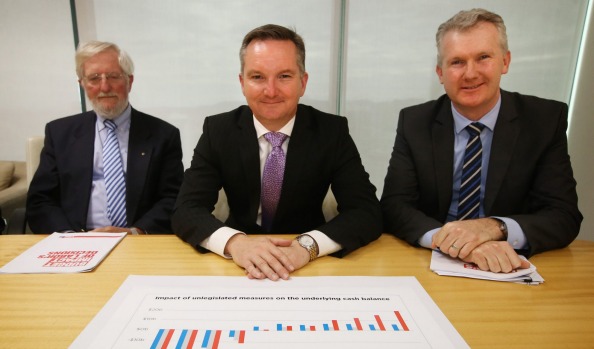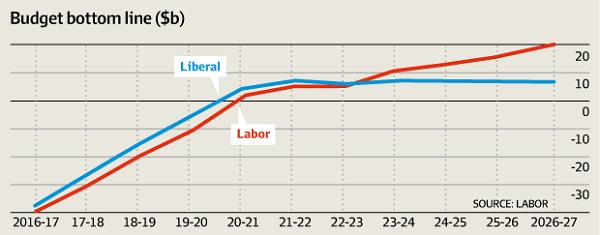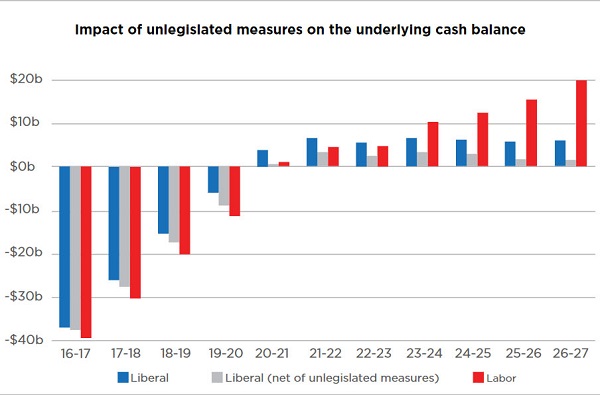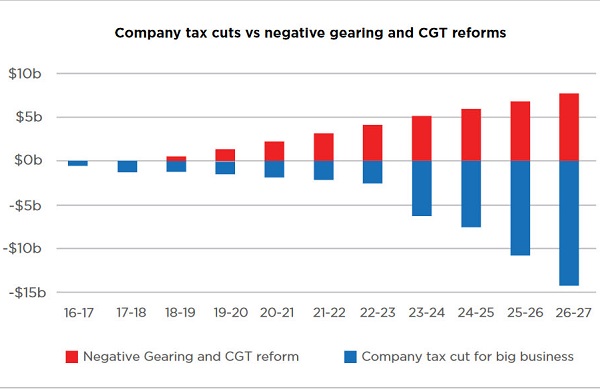The basic story of Labor’s costings could be told in one graph, but because of their media incompetence I couldn’t find a square-on shot of it on the net on Sunday. Here it is from the AFR:

The story is really quite simple. Labor makes structural improvements to the budget which lead to larger and growing surpluses over the longer term. The Coalition’s company tax makes the budget progressively more difficult in the out years.
Yet the take-out story has been that Labor’s deficits are a total of $16.5 billion worse that the Government’s PEFO calculations, which ScoMo reckons will jeopardise our credit rating. In part it’s lazy journalism. I heard the press conference and Chris Bowen and Tony Burke were very clear. There were 40 journalists present, and half a dozen TV cameras. However, the important journalists would have been in western Sydney at the official LNP launch. I’ve read a dozen articles, heard umpteen ABC news items, and what I get is largely the LNP’s response ($16.5 billion extra deficits will will jeopardise our credit rating) rather than Labor’s story. Barrie Cassidy earns $243,478 pa (2013) and all he gave us on TV on Sunday night was ScoMo’s line.
Michelle Grattan at The Conversation did reasonably well. The $16.5 billion is made up of:
- Labor would add $2.4 billion to the PEFO deficit in 2016-17; $4 billion in 2017-18; $4.7 billion in 2018-19 and $5.4 billion in 2019-20.
The cumulative deficits for Labor are $101 billion, for PEFO $84.5 billion, a difference of $16.5 billion But to that you have to add $6.9 billion in “zombie cuts”, the 2014 budget cuts that are still there and have been rejected by the senate. Taking them into account the difference shrinks to $9.6 billion over four years, which is negligible.
But by 2026-27 Labor’s surplus would be nearly $20 billion; the PEFO projection under LNP policies would be $6.2 billion, or $13.8 billion worse. As I understand that is without the company tax cuts added into the equation.
This morning the AFR had this graph, along with a tendentious headline about Labor blowing the budget:

The same one was on the ABC TV news on Sunday night. If anything it suggests similarity rather than difference.
By Googling again with different terms I found this Labor document and followed a link to their detailed costings in Labor’s Fiscal Plan. It’s the one to read. There on page 11 we have the graph:

The real contest is between the grey, which reflects the “zombie cuts” and red.
I’m not entirely sure what is included and what is left out of the out years, but the dividing of the ways are encapsulated in the effects of two decisions. Firstly, the LNP company tax cuts only cost $4.4 billion in the first four years, but in the 10th year they grow to $14.2 billion each year. Conversely, Labor’s negative gearing and capital gains policy will only save $1.9 billion in the first four years, but by the 10th year they will save $7.7 billion each year.
That’s a $22 billion difference to the budget bottom line each year as shown in this graph:

That’s pretty much the guts of the choice before us, which the journalists missed entirely, except, to be fair, the Courier Mail had it in small type on page 10.
The document was prepared with assistance from the Parliamentary Budget Office and signed off by a panel of three gentleman distinguished in the field.
Malcolm Farr foreshadowed that the LNP will bring out an updated set of costings (Tuesday, I believe). As he says the numbers though modest in context sound big and scary for Labor, and it will suit the LNP to be talking this stuff just before the election.
It’s possible the LNP costings will include a higher iron ore price, making their case look better. Chris Bowen explained that he had taken the budget assumptions as the basis of Labor’s calculations. He didn’t believe them, but it was the only way of comparing apples with apples.
Craig Emerson in a recent column pointed out that in the budget assumptions:
- Australia’s nominal GDP growth is forecast to accelerate from 1.6 per cent in 2014-15 to 4.25 per cent in 2016-17 and 5 per cent thereafter.
He reminds us that while nominal GDP rose 3.1 per cent:
-
in the March quarter, the 17th successive quarter during which it has declined or flat lined. Translated into dollars, Australians on average are $867 a year worse off than they were at the end of 2011, a fall in living standards of 6 per cent.
And despite the unemployment rate having risen only a little, from 5.3 per cent in late-2011 to 5.8 per cent in May 2016, the labour underutilisation rate has risen from 12.5 per cent to 14.2 per cent. This rate, reported by the Australian Bureau of Statistics, measures unemployment, underemployment and discouraged workers who have stopped looking for a job.
In other words, there are fundamental weaknesses in the economy and the budget assumptions are crazy brave.
Bowen says Labor will bring down a MYEFO, effectively a mini-budget, within the first 100 days.
I think Labor has quite a good story to tell, but told it poorly. Certainly it’s not “the most comprehensive plan an opposition has released in living memory on our economy”, but they’ve put in a decent effort which hasn’t penetrated the essentially shallow media. The LNP had six dot points, based around such things as the company tax and trade deals, but Turnbull has made it sound plausible, and the journalists pick up his lines.

You’re right of course, $16.9 billion in total over 4 years is within any reasonable margin of error in the forecasts, given ordinary fluctuations (let alone the ‘increased volatility’ so many folk are talking of just now).
Thank you, once again Brian, for your diligent digging.
I don’t think it was a mistake to hold the press briefing during the Coalition launch. I listened to a broadcast of that: Mr Turnbull very calm, forceful, direct and brief. (Unlike his sometimes hesitant, stumbling, waffle in face-to-face interviews.)
Unfortunately he reminded me of an old Peter Sellers recital called Party Political Speech.
“We must build; but we must build surely!”
Pretty much one wants to overspend way to much, and the other want to overspend a little bit more than that.
Ambigulous, I’m actually stunned that people like Ross Gittins, Peter Martin, even Quiggers on his blog, can let this one go through to the keeper. Laura Tingle has tried to keep up, but has come up short IMHO.
Jumpy, I can’t see anything Labor is proposing as wasteful and unnecessary expenditure. They’ve upped spending as a percentage of GDP, slightly over the 24%, held as the magic limit by the LNP, but only marginally.
It’s about a decent and fair society, while still being prudent.
Jumpy: Glen Stevens said very recently that the key economic problems in Aus at the moment are an overpriced $Aus and too low inflation. Under these conditions the most responsible thing to do is to spend to stimulate and pay for it by printing money.
The last thing we need is this ridiculous race to balance the budget without printing money.